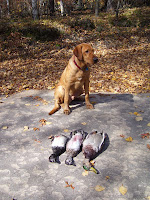
I have said it before, and I will say it again. When there is snow on the ground and the sloughs are frozen, that is my favorite time of the year to hunt pheasants. This season we have had snow and freezing temps across the Midwest. So last weekend my father and I took advantage of the weather that has be absent the last couple hunting seasons to chase pheasants.
In an article, legendary outdoor writer Tony Dean said that South Dakota is the best place for hunters to pursue pheasants. With South Dakota having lots of pheasants and plenty of opportunities for hunters, I believe that Tony is right. My father and I both had a second five-day period available on our licenses so we chose to go back to Sodak.
Freelancing pheasants in South Dakota is like freelancing ducks in North Dakota. Basically there are birds all over the state and to be successful you have to be mobile. Knowing different areas is crucial, so we decided to hunt pheasants in an area we have never hunted for them in.
Our goal was to target cattails for the majority of our hunts. When the water beneath them is frozen, cattails provide excellent cover for late-season pheasants. Plus, it is cover that, for the most part, has just recently become accessible. I was hoping that hunters had overlooked these spots so far this season.
The two of us ended up hunting mostly Waterfowl Production Areas with the three labs we brought along. Waterfowl Production Areas or WPAs are public lands open to hunting that are purchased through Federal duck stamp dollars. These lands always have some form of water on them and are natural places to find cattails. Pheasant hunters have to remember that steel-shot is legally required on Waterfowl Production Areas.
My father and I ended up hunting Federal land, but the state of South Dakota has public land available to hunters as well. Most of the land I saw that was purchased by the state had food plots on it. South Dakota also has state funded Walk-In areas. These land plots are only accessible by foot, like the majority of public land. The state basically leases the land for the Walk-In areas from farmers, and opens the land up for public hunting. Pretty cool.
I feel that most hunters when freelancing just open up a public hunting map and say, ‘look at all the public land around here.’ Usually pointing out a few areas of concentration and suggest to others that they go there. These are places that I try to avoid. I don’t have any problems with putting on a few extra miles to avoid other hunters.
Blocking strategies for jumpy birds and dogs for finding birds that are holding are a must when hunting pheasants later in the season. We had the dogs, but we could have used some blockers. Still we were able to find a handful of roosters that were willing to hold in the snow and cold.
On our recent trip my father and I discovered that our new spot is a good one. It is always a pleasure to hunt with a good friend in a new area. Next season we are planning on going back and bringing a few more shooters. Now that we have hunted a few different areas, we know how to cover them the right way.
On the drive home from South Dakota I was pleasantly surprised by the number of pheasants my father and I spotted. We probably saw twenty-five birds feeding in cornfields while we were driving along I-90. The funny thing is that we didn’t spot a single one from the Interstate in South Dakota. I almost couldn’t believe that all the birds I saw were on the Minnesota side of our drive.











